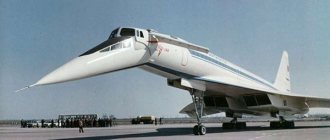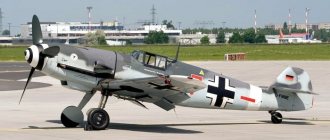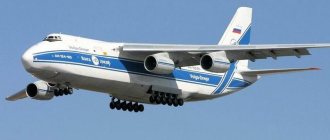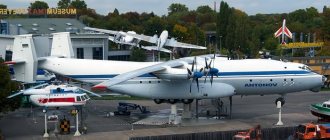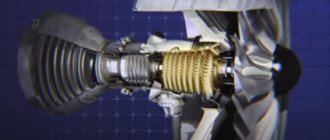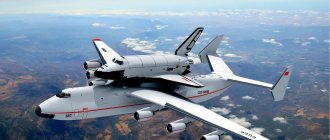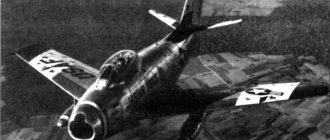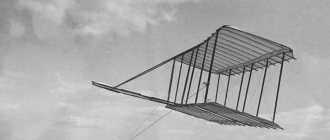F-4 Phantom 2 Dimensions. Engine. Weight. Story. Range of flight
In September 1953, she began to create an all-weather twin-engine fighter, and in July 1955, a contract was signed for the construction of two experimental XF4H-1 and five pre-production aircraft, which were called Phantom 2 (there was already an aircraft called Phantom earlier). . The technical design of the fighter was completed in August 1956. Phantom 2 made its first flight on May 27, 1958. 23 aircraft of the experimental series were subsequently designated F-4A and were used only for flight tests, during which higher flight performance was obtained. technical specifications than expected.
Airplane F-4 Phantom 2 - video
In December 1960, deliveries of the production version began for the US Navy, which in September 1962 received the designation F-4A. When production of the Phantom 2 ceased in October 1979, 5,057 vehicles had already been produced, of which 1,196 were for foreign consumers. In addition, Mitsubishi built 127 F-4 aircraft under license. The total number of aircraft produced thus reached 5,195 aircraft (which can only be rivaled by the MiG-21 fighters).
The Phantom 2 aircraft at one time set absolute world records for flight altitude (30040 m) on December 6, 1959 and speed (2585.43 km/h) on November 22, 1961. World speed record at low altitude (1452 km/h) lasted 16 years. Considering the huge role that F-4 aircraft played in the fighting in Vietnam, it can be said that the Phantom 2 was one of the world's best military aircraft of its time.
Modifications
F-4B (F4H-1) - variant with J79-GE-2U-2A engines with a thrust of 7326 kg. The strike version of the F-4B was equipped with an APQ 72 fire control radar and could carry up to 7257 kg of various strike weapons.
QF-4B is the designation for F-4B aircraft converted to unmanned target aircraft.
The RF-4B (F4H-1P) was an unarmed photo-reconnaissance aircraft based on the F-4B with a long nose for the US Navy (first flight March 12, 1965).
The F-4C is a fighter-attack variant similar to the F-4B. but with dual control and J79-GE-15 engines with a thrust of 7711 kg and other changes in the aircraft systems (first flight 27 MAN 1963).
EF-4C is the designation for F-4C aircraft converted to the Wild Weasel configuration for electronic warfare.
The RF-4C is a tactical reconnaissance aircraft based on the F-4C but equipped like the RF-4B (first flight May 18, 1964).
The F-4D is a production version for the US Air Force. similar to the F-4C but equipped to meet Air Force missions (first flight December 8, 1965)
EF-4D is the designation of F-4D aircraft converted to the Wild Weasel configuration (electronic reconnaissance and fire suppression of air defense radars).
F-4E - the main production version with more powerful J79-GE-17 engines, increased fuel reserves, a new APQ-120 radar with smaller dimensions due to the transition to microelectronic circuits, with slats to improve maneuverability and a built-in 20-mm six-barreled gun with ammunition 639 rounds (first flight June 30, 1967). On a number of F-4E fighters, the Tiseo television air target tracking system was installed in the toe of the right wing console, allowing the identification of enemy aircraft at a great distance.
F-4E(J) is a variant of the F-4E, produced in Japan under license and by Kawasaki.
The RF-4E is an export version of the F-4E, equipped for tactical reconnaissance.
RF-4E(J) - unarmed reconnaissance version of the F-4E(J) for the Japanese Air Force.
F-4F is a variant of the F-4E for the German Air Force, modernized by the MVV corporation in 1991.
The F-4G Wild Weasel was a variant of the F-4B (first flown March 20, 1963) used in Vietnam with the ASW-1 ground attack data link system. Subsequently, this designation was given to the F-4E series aircraft, converted to the Wild Weasel configuration (first flight December 6, 1975). The conversion of the first production F-4G aircraft was completed in April 1978, and it began entering service that same year.
The F-4G "Wild Weasel" is designed to detect and suppress air defense radars on the flight routes of attack aircraft to strike targets when breaking through enemy air defenses, as well as to perform independent operations to suppress the air defense system. To destroy enemy air defense systems, anti-aircraft missiles, AGM-65 Maverick air-to-surface missiles with an optoelectronic seeker, and cluster munitions are used to destroy area targets.
In this mission, F-4G aircraft must be the first to enter the combat zone to suppress enemy ground-based air defenses. Escort of attack aircraft is carried out when breaking through the air defense zone and deep penetration into enemy rear areas. At the same time, the F-4G is tasked with creating a safe passage corridor for attack aircraft to reach the target. Depending on the type of target, installed weapons and the nature of combat operations, the F-4G aircraft can fly at medium and low altitudes. Attacking a target and flying close to it is carried out at an altitude of 60-300 m at high subsonic speeds.
The F-4G and E aircraft use: ANyAPQ-120 targeting navigation radar, AN/ASQ-91 missile launch control system computer, AN/ARN-101 digital INS, AN/ALE-40 dipole reflector and IR trap reset equipment, combined with radar exposure warning system. The weapons compartment contains 25 quick-detachable units of the APR-38 electronic reconnaissance-detection and location of radar radiation sources station.
The F-4G defensive electronic equipment includes a container with equipment AN/ALQ 119-12 (-14) for jamming in the frequency range from 2 3 to 8-10 GHz or a container with equipment for jamming AN/ALQ-131. The main avionics of the F-4G aircraft is the AN/APR-38 system. included HAWC computer to provide crew members with classified threat data, system control in various modes of its operation, CIS display unit, AN/APQ-30 (Mod) optical sight and superheterodyne unit. The AN/APR-38 system is designed to detect radar emissions from all existing Soviet pulse and continuous wave radars. The F-4G is armed with a high-speed AGM-88A/C HARM anti-aircraft missile system, which can be used for self-defense or to engage specified or suddenly detected targets. The aircraft's armament may also include other anti-aircraft missile systems, guided weapons launched outside the enemy's air defense zone, and conventional weapons.
The F-4J is a carrier-based multi-role fighter aircraft of the US Navy (first flight May 27, 1966), with J79-GE-10 engines of 8119 kg thrust. enlarged wing and redesigned tail to improve takeoff and landing performance, equipped with an automatic carrier landing system.
F-4K is a modified version of the F-4J for the British Navy with Rolls-Royce Spey RB.168-25R Mk.202/203 engines with a thrust of 9305 kg. In the British Navy, these aircraft received the designation “Phantom” FG Mk.1.
F-4M is a modernized version of the F-4K, designated in the British Navy as the Phantom FGR Mk.2.
The F-4N is a US Navy carrier-based fighter based on the F-4B with a reinforced structure and equipped with advanced electronic equipment (first flight June 4, 1972).
The F-4S is a modernized version of the F-4J with a reinforced structure and installed slats. The aircraft is made according to a normal aerodynamic design, with a low-swept trapezoidal wing with folding consoles and a swept tail. The aircraft's fuselage is a semi-monocoque type, its nose part is lowered down to improve visibility from the cockpit. The chassis is tricycle. The front strut with two wheels is retracted back, the main struts are retracted into the fender.
The F-4E aircraft is equipped with two turbofan engines. Fuel is stored in seven flexible fuel tanks in the upper part of the fuselage and two integral tanks in the middle part of the wing. In addition, two PTBs are mounted under the wing and fuselage. There is an in-flight refueling system using a telescopic rod (for Air Force aircraft) and a hose-cone system (for deck-based vehicles).
The control is irreversible booster, with a hydraulic drive and a damping system on three axes. There is an AN/ASA-32 self-propelled gun. The weapon control system of the F-4E aircraft includes an AN/APQ 120 pulse-Doppler radar (capable of detecting air targets only against the background of free space at a maximum range of 70 km), an AN/ASQ-26 optical sight, and an AN/AJB navigation and bomber subsystem -7 and AN/ASQ-91 bombing computer. Electronic warfare equipment includes AN/APR-36/37 radar detection receivers and AN/ALO-71/72/87 jammers.
The F-4E flight navigation system consists of the AN/ASN-63 INS, the AN/ASN-46 computer and AN/APN-155 low-altitude radio altimeter. For communication between radio navigation and identification, there is an integrated AN/ASQ-19 system, including a transceiver for the TACAN navigation system. On nine external hardpoints, the F-4E can carry four AIM-7 Sparrow medium-range missiles in a niche under the fuselage, the Sparrow missile. “Sidewinder” and “Shrike” on underwing hardpoints, as well as two or three SUU-16/A or SUU-23/A containers with M61A1 cannons (ammunition capacity of 1200 rounds per gun), units with NAR, free-falling bombs, aircraft pour-out devices on the underwing and central ventral units. The aircraft can be armed with two nuclear bombs Mk.43, Mk.57. Mk.61 or Mk.28. For action against ground targets it can be equipped with six ASM-65 Maverick missile launchers. The F-4 fighter has long remained the main air superiority aircraft of the US Air Force and Navy. The Phantom’s “baptism of fire” took place on April 2, 1965 in Vietnam, where aircraft of this type met with North Vietnamese MiG-17F fighters. Since 1966, the main opponents of the Phantom have been the MiG-21PF aircraft. “Phantoms”, which are in service with the Iranian Air Force, were used in the Iran-Iraq War (1980-1988).
The Story of a Ghost (F-4 Phantom-2 Fighter)
We can safely say that the McDonnell-Douglas F-4 Phantom 2 aircraft, in the eyes of both specialists and people far from aviation technology, has long been associated with the entire US fighter aviation, becoming a kind of symbol of American air power. The history of its birth (like most other “second generation” jet fighters) dates back to the Korean War (1950-1953). Then America, confident of its qualitative superiority over its enemy, unexpectedly encountered equipment superior in combat qualities to its own - the MiG-15 aircraft. Among the entire fleet of US Air Force fighters, only one - the North American F-86 Saber - turned out to be capable of fighting with it on an equal footing. The Navy's carrier-based fighters - the McDonnell F 2H "Banshee" and the Grumman F9F "Panther" (with a straight wing) were inferior to the "Migs", and the newest Vought F 7U "Cattles" (according to the "tailless" design with a swept wing) became impossible to use from the deck of ships due to its poor takeoff and landing characteristics. Somewhat later, the US Navy received carrier-based fighters Grumman Cougar (a modernized Panther with a swept wing), North American Fury (a naval version of the Saber with a folding wing and a brake hook), as well as an all-weather single-seat fighter McDonnell F3H-2N " “Demon” is a relatively heavy vehicle with a swept wing and an engine arranged in a configuration close to the redundant one (exhaust gases washed the rear fuselage). This layout of the power plant for many years became a distinctive feature of the McDonnell and McDonnell-Douglas fighters). In the nose of the Demon there was a powerful PJIC, which made it possible to detect air targets at night and in difficult weather conditions. Armament included four cannons (20 mm) and 76 NAR (70 mm). According to American experts, the Demon was the most modern US Navy fighter of the early 1950s, combining powerful weapons, the most advanced avionics for that time with high flight characteristics (maximum speed - about 1200 km/h, service ceiling - 13,700 m , ferry range - 3200 km). However, due to the low reliability of the engine, this vehicle never took part in combat operations in Korea; its normal operation from the deck of aircraft carriers began only in the mid-1950s after a series of modifications. Simultaneously with work on a carrier-based fighter, McDonnell was actively developing combat aircraft for the Air Force. Back in 1948, it built the heavy “strategic” fighter XF-88 “Voodoo”. This was a huge aircraft for those times with a swept wing and two turbojet engines, developing transonic speed and capable of escorting strategic bombers deep into enemy territory (something like the Thunderbolt jet that escorted the Allied Flying Fortresses during the Second World War). Two prototype aircraft were built. However, further work on the program was suspended. For raids on North Korea, the range was quite sufficient (Sabers, more effective in air battles with the MiG-15 than the heavy Voodoo). In accordance with the changing requirements of the Air Force, a supersonic aircraft was required to cover the Boeing B-47 and B-52 strategic jet bombers. Work on it began at McDonnell in 1951. The prototype was the same “88”, but with a new wing and power plant. The fighter was designated F-101 "Voodoo". The second of the 100 series aircraft (the code name for the family of second generation jet fighters F-100, F-101, F-102, F-104, F-105 and F-106) took off in 1954. Its distinctive features were supersonic speed (1960 km/h, 1160 km/h at the ground), enormous range (practical without PTB 2700 km, ferry 4560 km) and powerful weapons (four 20 mm caliber guns and up to 1800 kg of bombs and NAR on three external suspension units). However, the refusal of the US Air Force Strategic Command from escort aircraft, as well as restrictions on overload caused by the insufficient strength of the aircraft structure, led to a revision of the Voodoo production plans: only 77 “strategic fighters” were produced, reclassified as F-I0IA fighter-bombers, and 47 F-I0IC, 201 reconnaissance aircraft RF-I0IA and RF-I0IC, 480 two-seat air defense fighters with missile (including nuclear warheads) ski-to-air weapons. The latter have long formed the basis of the continental air defense of the USA and Canada. In the 1950s, weapons developed at a rapid pace, and the characteristics of the carrier-based air defense fighter "Demon" and the daytime maneuverable "Cougar" soon again ceased to meet customer requirements. Subsonic deck-based ones could only successfully repel attacks on aircraft carrier formations of piston bombers, torpedo bombers and attack aircraft (Tu-2, Il-10, covered by MiG-15 and MiG-17), but jet torpedo bombers Tu-16T, Il-28T and Tu-14, supersonic MiG-19s would penetrate this barrier in all respects. In 1953, the US Navy announced a competition to create an aircraft that would close the gap. The firms Vought, Grumman and McDonnell took part in it. The first place was taken by the project of the Vought company. She received an order to build the F-8 Crusader fighter jets. A small series of F-11 Tiger fighters (a further development of the Cougar) was also ordered from Grumman. McDonnell turned out to be an outsider with her F3H-G project. The F3H-G existed as a prototype and was a further development of the Demon and Voodoo heavy fighters. The single-seat vehicle had two Wright J165 “Sapphire” turbofan engines (a licensed version of the English engine, produced in the USA) with nozzles located under the rear fuselage. The maximum speed had to correspond to M=1.5. The armament consisted of four cannons (20 mm), missiles and bombs on 12 external hardpoints. The highlight of the project was the use of a quick-detachable bow with electronic equipment. It could quickly be replaced with others depending on the combat mission, turning the interceptor fighter into a multi-role aircraft. Compared to the Crusader and Tiger, the F 3H-G fighter was too large in size and weight, which obviously predetermined the choice of lighter single-engine vehicles. However, powerful weapons, significant internal volumes for accommodating avionics, long flight range and the ability to solve a wide range of combat missions made it possible to create an excellent carrier-based fighter-bomber based on the F3H-G. The military took this into account, and on November 18, 1954, McDonnell received a contract to build two prototypes of such an aircraft. It was given the name AN-1. However, on December 14, 1955, the Navy’s mission was radically revised: instead of a fighter-bomber, the fleet needed a high-altitude, long-range carrier-based interceptor with “revolutionary” speed characteristics for its time (M=2). Instead of turbofans, they decided to use the latest General Electric J-79 engines, which were still under development at that time. The installation of cannon armament was completely abandoned, as well as 12 external suspension units. They were replaced by one ventral unit, designed for suspension of a 600 liter tank. The “main caliber” of the new fighter was to be Sparrow 3 guided missiles with semi-active radar guidance, tested on the latest modification of the Demon. One of the reasons for such a sharp “reincarnation” of the AN-1 project is the emergence of a new class of weapons - anti-ship guided missiles (ASM). Work on naval missile defense was carried out in Germany and the United States during the Second World War (suffice it to remember that the largest Italian battleship Roma was sunk with this weapon). However, the first anti-ship missiles had a command guidance system, which required visual tracking of the target and the missile from the carrier aircraft, so their launch range was short. But in the early 1950s, the USSR made a sharp “breakthrough” in the creation of anti-ship missile weapons. The A.I. Mikoyan Design Bureau developed the KS-1 winged anti-ship missile system, equipped with a turbojet engine and having semi-active radar guidance, a maximum launch range of up to 90 km and transonic speed. Initially, Tu-4K piston bombers were armed with these shells. The fight against them, although difficult, is possible with the help of the fighters available on US aircraft carriers. However, with the appearance in 1954 of the Tu-16K missile carriers with a speed of about 1000 km/h and a high flight altitude, the situation for the Americans became sharply more complicated: subsonic fighters simply did not have time to intercept the carrier aircraft before the KS-1 was launched at the aircraft carrier. Work also began on an even more powerful K-10 cruise missile system intended for the Tu-16. Its maximum range would have been 200 km, and it was designed for supersonic speed. To combat such aircraft and missile systems, a vehicle with a large interception range at “supersonic speed” was required, capable of patrolling for a long time at a considerable distance from the ship. Such an aircraft would have to rely primarily not on ship-based guidance systems, but on its own powerful on-board radar. This led to a new requirement: the interceptor fighter had to be designed as a two-seater, with an operator in the second cabin. All-weather fighters with purely missile weapons (F-86D, F-96D and F-94C) have been built in the United States before. However, all of them were intended for air defense of the American continent against strategic bombers. In 1948, the Douglas company created the carrier-based two-seat all-weather fighter F3D Skynight. The Sparrow 1 missile launcher was tested on it. However, the aircraft had low performance characteristics (maximum speed 850 km/h, rate of climb 10 m/s). It was built in the amount of only 70 copies and was used mainly as an experimental one, weapons and equipment were tested.
In July 1955, a full-scale model of the fighter was made, designated F4H-1F. In August 1956, its technical design was completed and construction of the first prototype aircraft began. However, one of its significant differences from the original project was the use of a 45-degree swept wing. (The ends of the consoles were tilted upward by 12 degrees; as a result, models in wind tunnels revealed unsatisfactory transverse static stability of the AN-I layout. Then the ends of the wing were given a positive transverse V angle). With the initial configuration of the wing at high angles of attack, flow stall was observed at the wing tips. To eliminate this phenomenon, the chords of the wing tips were increased by 10%, forming a characteristic “fang”. Lateral control on the aircraft was ensured by the joint deflection of the elevons and spoilers. Moreover, the elevons deflected only downwards, and the spoilers - only upwards. The roll moment was created by deflecting the elevon down on one wing and the spoiler up on the other. To ensure the necessary operating conditions for the engine over the entire speed range, an air intake of variable geometry was required, automatically adjusted using an aerodynamic data computer. A Westinghouse AN/APQ-50 radio sight with a parabolic antenna with a diameter of 610 mm was installed in the nose of the aircraft, providing interception and launch of Sparrow 3 missiles (they decided to abandon the replaceable nose cones offered by the company for the F3H-G fighter). In May 1958, the new fighter was solemnly, to the sound of an orchestra, rolled out of the assembly shop of the McDonnell plant in Lambert Field. On May 27, her chief pilot R.S. Little taxied onto the hot runway and pushed the throttle forward all the way: the F4H-1 took off for the first time. Despite the fact that the design characteristics of the new aircraft were quite satisfactory for the Navy, still, “just in case,” they were looking for an alternative, cheaper version of an all-weather carrier-based interceptor. In particular, the Vought F8U-3 “Crusader” 3 project was considered - single-seat, with folding ventral fins of a large area and one Pratt-Whitney J75-P-5A turbofan engine (Ixl 1,400 kgf). However, work on the McDonnell machine was successful and the development of the F8U-3 was soon stopped. In December 1958, the US Navy signed a contract for the supply of 23 pre-production and 24 production F4H-I fighters, called “Phantom” 2. The founder of the company, D.F. McDonnell, of Scottish origin, in the “best traditions” of his people with great “respect” belonged to evil spirits. Hence the “branded” names of his aircraft - “Demon”, “Phantom” (ghost), “Will” (sorcerer), “Benshi” (in Celtic legends - the howl of evil spirits, harbingers of death). However, the cost of one pre-production aircraft turned out to be far from illusory - $7.4 million. The first experimental Phantom was equipped with a General Electric J79-ZA turbofan engine (2×6715 kgf). After 50 test flights they were replaced by the J79-G E-2, then by the even more powerful J79-G E-2A (2×7325 kgf). The YF4H-I immediately loudly declared itself, “taking away” a number of world speed and altitude records from the Su-9. On December 6, JI.Flint, taking off from Edwards Air Base, rose to a height of 30,040 m, exceeding the dynamic ceiling achieved by the same Su by more than 1,200 m. In 1960, Phantom 2 set world speed records for 100 and 500 km closed routes. In 1961, the 50th anniversary of US naval aviation was celebrated. The Americans celebrated this anniversary with a series of record flights: in May, the YF4H-I flew from New York to Los Angeles in 2 hours 49 minutes. 9.9 s, in August set the world speed record at low altitude - 1453 km/h. On November 22, the experimental F4H-I N2, piloted by R. Robinson, set its absolute record - 2583 km/h (on this Phantom, to increase traction, the engines were equipped with a system for injecting a water-alcohol mixture into the space in front of the compressor to cool its blades. In total, with From 1950 to 1969, the Phantom set 16 world records in various categories. The production of pilot series aircraft was gradually overgrown with technical improvements. The seventh fighter was equipped with a boundary layer control system (BLC). It contributed to the improvement of takeoff performance. landing characteristics. On the 19th, instead of PJ1CAN/APQ, a much more powerful AN/APQ-72 station with an antenna diameter of 813 mm appeared. This caused “inflating" of the nose radio-transparent fairing. To improve forward-downward visibility for the second crew member, a canopy was made more convex and slightly protruding above the fuselage.In accordance with NACA recommendations, the shape of the main air intakes and air conditioning system intakes installed immediately behind the PJ1C fairing has changed. All 23 aircraft of the experimental series were later designated F-4A and were used only for flight tests. During them, JTTX turned out to be higher than expected. In addition, it was found that the controllability characteristics of an aircraft with suspended missiles are somewhat better than those of a machine without external suspensions. In December 1960, the aircraft plant in St. Louis began serial production of F4H-I aircraft, renamed F-4A. The fighters had two internal under-wing pylons LAU-17/Ad for suspension of Sparrow and Sidewinder missiles, two external under-wing pylons MAU-12 for suspension of PTB, as well as a central ventral pylon with Aero-27A pyro pushers. The Aero-IA fire control system included an AN/APQ-72 radio sight with radar>4/ARA-157 to illuminate an air target when launching Sparrow 3 missiles. In February 1960, flight tests began on board aircraft carriers of six prototype F aircraft -4A. In 1961, the first production fighters of this type entered combat units. They were equipped with the Navy YF-121 Peacemaker training squadron stationed in California. After building 47 F-4A aircraft, McDonnell-Douglas began producing an improved modification of the F-4B carrier-based fighter (the first prototype took off on March 25, 1961). Just like the last production F-4A, the new Phantoms had five external hardpoints for placing bombs, drop tanks, unguided missiles and Sidewinder missiles with an IK homing system and four semi-recessed ventral assemblies - “nests” for missiles “Sparrow” 3. We installed a General Electric ASA-32 autopilot and a Lear AJB-3/A bomber sight/computer, located in the forward fuselage. It became possible to use the vehicle as a tactical bomber. The ACF AAA-4 thermal direction finder was installed directly under the radar antenna in a separate radome. The first squadron of F-4Bs was deployed aboard the attack aircraft carrier USS Saratoga in October 1960. In 1962, fighters began to enter the US Marine Corps. Actually, the designation “F-4B” was assigned to the Phantom only in September 1962, when the US Department of Defense introduced a unified aircraft indexation for all branches of the military. From June 1961 to March 1967, 637 Phantoms were delivered to the Navy and Marine squadrons (some of them were later converted to other modifications). The aircraft were equipped with an in-flight refueling system using the “hose-cone” method (the fuel receiver rod was installed to the right of the pilot’s cockpit and was retracted into the fuselage when not in use). In April 1963, flight tests of the F-4G carrier-based fighter-interceptor began (the first with this name, which should not be confused with the F-4G "Widd Weasel" anti-radar fighter). The vehicle was equipped with an automated noise-proof command line AN/ASW-21 (something like the Soviet Lazuri installed on the MiG-21, Su-9 and other interceptors). Additional electronic equipment was located directly behind the cockpit, instead of fuel tank No. I. All 12 aircraft of this type built were sent to Vietnam in December 1965 as part of the YF-213 Black Lions squadron. She operated from the aircraft carrier Kitty Hawk. The planes had a new camouflage coloring. After returning from Vietnam, all F-4Qs were converted to standard F-4Bs: the use of the AN/ASW-21 system in combat conditions did not justify itself. The experience of combat use of the F-4B in Vietnam required a number of changes to be made to its design. In accordance with the modernization program, the F-4N carrier-based fighter was created, which has a reinforced structure and improved equipment. At the Navy aircraft repair facility, the F-4N variant was developed in 1973-1978. converted 301 F-4Bs. An even more radical modification of the carrier-based Phantom was the F-4J fighter, which made its first flight on May 27, 1966. It had a new AN/AWG-10 airborne radar system, an AJB-7 bomber sight-calculator, similar to that installed on the F-4C, and AN/APR -32 RHAW radar warning system, the antennas of which were mounted in the upper part of the keel. The F-4J was the first production fighter to be equipped with the Honeywell YTAS helmet-mounted target designation system, which is used to control the guidance of thermal missile homing heads by rotating the pilot's head. A visor was mounted on the helmet, in the frame of which the pilot “held” the enemy aircraft. A special system tracked the spatial position of the helmet (and, consequently, the visor) and used it to determine in which direction the target was located, orienting the missile homing head in the same direction. In the mid-1970s, an order was issued for 500 sets of this system. However, it did not “take root” on airplanes, and was soon forgotten about. Somewhat later, already in the 1980s, more advanced systems for this purpose appeared on the MiG-29 and Su-27 fighters. The internal fuel capacity of the F-4J was increased by installing an additional seventh fuel tank. The aircraft used new J79-JE-10 engines with increased thrust and improved Martin-Breaker Mk.7 ejection seats, capable of “shooting pilots at zero speed and altitude. From December 1966 to July 1972, 522 F-4J aircraft were delivered to the US Navy and Marine Corps. Its further development was the F-4S fighter, created in J 978 (previously built ones were converted into these machines). Compared to the original aircraft, the F-4S had a strengthened structure, upgraded equipment and a J79-JE-10B engine. As on the “land” F-4E, it used slats instead of deflectable toes, which somewhat increased horizontal maneuverability. The electronic warfare equipment was supplemented with the AN/ALQ-126 active jamming system (antennas were installed on the air intakes). The undoubted success of the Phantom, created by order of the Navy, contrasted with the failures of the US Air Force fighter program. In fact, the Lockheed F-104 Starfighter tactical fighter, the arrow-shaped creation of Kelly Johnson, widely advertised by the Americans as the best machine in its class in the world, turned out to be unsuitable for use in real combat conditions due to its enormous landing speed. With a high maximum speed and ceiling, the Starfighter turned out to be insufficiently maneuverable, inferior to the MiG-21 and Mirage III in this most important parameter. The layout of the fighter prevented the placement of any serious bomb weapons on board, and the small size of the on-board PJIC compartment limited the ability to autonomously detect enemy air. To top it all off, the Starfighter broke all accident records and earned the disreputable nickname “flying coffin.” Under these conditions, the Air Force decided to abandon departmental ambitions and turn to sailors for help. In January 1962, two F4H-Is were transferred by the Navy to the Air Force Combat Weapons Center at Langley AFB for evaluation of the Phantom in the tactical fighter role. There, comparative tests of the F4H-1 and the most powerful interceptor of the US Air Force, the Convair F-106 Delta Dart, were carried out, which proved the superiority of the deck-based vehicle, and already in March 1962, the aircraft under the designation F-110A Phantom-2 was adopted by the military -air forces. In April 1962, 280 F-110A fighters were ordered; in September, the “land” Phantoms were again, finally, renamed and began to be called F-4C. The first production F-4C took off in May 1963. By 1966, the US Air Force received 583 fighters of this type. Several vehicles were modified into the radar version of the EF-4C (the first flight took place on June 4, 1972; from 1973 to 1978, 148 vehicles were converted). It differed from the original deck-based F-4C in its lightweight chassis (the requirements for withstanding a “hard” landing on the deck of an aircraft carrier were removed), and a lighter brake hook (it only served as an emergency braking device). The wheel size has been increased. To increase combat survivability, the rear cockpit was equipped with the main controls of the aircraft. This required a radical redesign of the instrument panel for the operator, who now needed good forward and downward visibility. The Navy's hose-to-cone refueling system was replaced with a standard Air Force fuel receiver that operates with a telescopic rod. The engine starting system has been changed. The avionics also underwent changes: the aircraft received an inertial navigation system Liton AN/ASN-48, interlocked with the AJB-7 bomber sight-computer and forming a sighting and navigation complex. This significantly increased the striking potential of the machine.
The weapon system was modernized, and the aircraft was able to carry AGM-12 Bullpup air-to-ground guided missiles on underwing pylons. On May 27, 1963, the first F-4C was rolled out of the assembly shop onto the concrete of Lambert Field airfield, and in January 1964, the Phantoms already entered service with the 4453rd Training Wing of the US Air Force at MacDill Air Force Base (Florida). The first batch of F -4Cs were sent to Vietnam in 1965. In 1972, F-4Cs began to be gradually withdrawn from service with combat units of the Air Force, transferred to the National Guard, reserves, or sold abroad. So, 32 were delivered to the Spanish Air Force. The F-4C was replaced by tactical fighter F-4D "improved Phantom" (as this modification was called in some US Air Force documents). The first took off in December 1965. In 1966-19o8, the Air Force received 825 aircraft of this type. A new AN / APQ radio sight was installed on the aircraft 109, capable, unlike the radars used on Phantoms of previous modifications, to operate in radio rangefinder mode when operating against ground targets, which further expanded the scope of its combat use.The pilot received a new optical sight AN/ASG-22, integrated with a bomber computer ASQ-91. Instead of the AN/ASN-42 INS, a new initial ASQ-63 navigation system was also used. It provided greater accuracy in determining current coordinates. The avionics were installed instead of fuel tank No. 1, located directly behind the cockpit. On the first series of F-4C there was no heat direction finder, then the fairing of this device reappeared in the nose of the Phantom. However, instead of an IR sensor, an antenna of the APR-25/26 RHAW radio reconnaissance system was placed in it. It provided the possibility of using AGM-45 Shrike anti-radar missiles. The armament of the new modification of the fighter included a short-range air-to-air missile with an IK homing system AIM-4 "Falcon". Previously, they were used on the Northrop F-86H "Scorpion", Mawdonnell F-101B "Voodoo", Convair F-102 "Delta Depere" and F-106 "Delta Dart" interceptor fighters and were available in large quantities at Air Force warehouses), containers SUU-16A with a six-barreled Vulcan cannon (20 mm), then replaced by more advanced SUU-23A, as well as the latest achievement in the field of aviation weapons of that time - adjustable bombs. To use a KAB with a laser passive homing system, a container with a Pave Knife laser searchlight was suspended under the wing (when correcting the flight of a bomb, the aircraft with the laser turned on had to dive strictly at the target. Since 1977, this system has been replaced by the AN/ASQ-153 container "Pave Spike", which included a laser searchlight and a television camera capable of being aimed in elevation and azimuth and used to automatically hold the target. For the use of bombs with a television homing system, a small television monitor was mounted in the operator's cabin. Combat use of the F-4D in Vietnam began in the spring of 1967, then 32 aircraft were delivered to Iran and 90 to South Korea. The most successful and widespread modification of the Phantom was the F-4E. During its creation, the experience of the combat use of US aviation in Vietnam was taken into account. The first flight of the aircraft took place on 30 June 1967. From 1967 to 1976, 1387 F-4Es were built, externally distinguished by a longer and narrower nose, giving the aircraft a predatory, “shark-like” appearance. Unlike the rest of the Phantoms, which were essentially fighter-interceptors adapted to solve strike missions, the new modification was created mainly to fight for gaining air superiority (it was necessary to achieve a turning point in air battles over North Vietnam, and the previous ones modifications of the F-4 were unable to solve this problem). One of the main differences of the new modification was the installation in the forward part of the fuselage, under the radar, of a six-barrel 20-mm cannon MG1-AI “Vulcan” - a powerful weapon with a firing rate of 6000 rounds per minute and a high initial projectile speed, an effective means of combating both air and ground targets. The F-4E received a new Westinghouse AN/APQ-120 radio sight with an antenna of reduced diameter (previously it was reported that the sight was capable of detecting air targets against a background of mud, but this information was later not confirmed). When switching to microelectronic circuits, the weight of the fighter's avionics decreased by 40% compared to the F-4B aircraft. Martin-Baker N Mk.7 ejection seats were installed in the cockpit, making it possible to leave the aircraft in a wider range of modes, in particular, at zero speed and altitude. To compensate for the increase in aircraft weight caused by the installation of cannon armament and additional equipment, more powerful J79-JE-17 turbofans were used on the F-4E. In 1968, the first F-4E was sent to Vietnam for military testing, and in 1970, the planned rearmament of US Air Force squadrons stationed in Da Nang with new fighters began. The combat use of the new aircraft revealed a number of defects and design flaws, which specialists from the Mavdonnell company dealt with. Douglas has come] to tinker a fair bit. Thus, to prevent powder gases from being sucked into the engine air intakes when firing a cannon, the gun barrels were lengthened. In the early 1970s, instead of deflectable slats, fixed flaps were installed on the toe of the wing. This made it possible to slightly reduce the radius of the turn. Then similar modifications were carried out on Navy vehicles (F-4S). On a number of fighters, the TISEO television system was installed in the forward right wing console. It had optics with a high magnification factor and was intended for tracking air targets, making it possible to identify enemy aircraft at a considerable distance in conditions of good visibility. The F-4E has become one of the most popular aircraft in the air forces of many countries. Supplied to Australia, Greece, Egypt, Israel, Iran, Turkey, Germany, South Korea and Japan (F-4EJ). On the basis of the F-4, a modification of the F-4F with simplified avionics and weapons was created for the German Air Force.
Vladimir ILYIN
Wings of the Motherland, No. 3'1994
Performance characteristics of the F-4 Phantom 2
— First flight: May 27, 1958 — End of operation: 1992 — Units produced: 5195
F-4 Phantom 2 crew
— 2 people
Dimensions F-4 Phantom 2
— Wingspan, m: 11.70 — Aircraft length, m: 19.20 — Aircraft height, m: 5.00. — Wing area, m2: 49.20 — Sweep angle along 1/4 chords, degrees: 45
Weight F-4 Phantom 2
- empty aircraft: 13760 - fuel: 6080 - normal take-off weight: 20800 - maximum take-off weight: 26330
Engine F-4 Phantom 2
— 2 x General Electric J79-GE-17 turbofan engines — Maximum thrust, kN: afterburning 2 x 53.00 — Maximum thrust, kN: afterburning 2 x 79.60
Speed F-4 Phantom 2
— Maximum speed at low altitude, km/h: 1200 (M = 1.15) — Maximum speed at high altitude, km/h: 2300 (M = 2.2) — Maximum rate of climb, m, min: 15000 — Take-off run , m: 1340 — Run length with braking parachute, m: 950
Service ceiling F-4 Phantom 2
— 16,600 m
F-4 Phantom 2 flight range
— 2380 km (without PTB)
Armament of the F-4 Phantom 2
— 1 × 20 mm six-barreled M61A1 Vulcan cannon (639 rounds), — Combat load on 9 external hardpoints — 4 AIM-7 Sparrow medium-range missiles in niches under the fuselage, AIM-7 Sparrow, AIM-9 Sidewinder, AIM-4 missiles Falcon, Bullpup or Shrike missile launchers on underwing hardpoints, 6 AGM-65 Maveric missile launchers. - blocks with NAR, free-falling bombs - The aircraft can carry two nuclear bombs Mk 43, Mk57, Mk61, Mk28.
F-4 Phantom II— MYUKHANKEE LYUYAYANBSHI LMNTsNZHEKEBNI PEYUYRKHBMSHI KHYARPEAHREKE hleer BSHYANYKHE KERMSHE UYUPYUREPHYARKHYKH, ONDRBEPFDEMMSHE YAEPKHEI LHPNBSHU PEINPDNB. b OEPKHND I 1950 ON 1969 TsND MU "TUMRNLE" ASHKN SYARYUMNBKEMN 16 LHPNBSHU PAINPDNB (YAYNPNYARKH, BSHIANRSH ONZELYU, YAYNPNYARKH ON GYULYMSRSHL 100- X 500-YHKNLERPNBSHL LYUP LPSRYUL X DP). yNMYARPSYZHKH YYULNKERYU BSHONKMEMU ON MNPLYUKEMNI YUSCHPNDHMYULHVEYAYNI YAUELE I MKHGYNPYYAONKNFYAMMSHL YARPEKNBHDMSHL RPYUOEZHHEBKHDMSHL YPSHKNL, KHLECHYHL YAYKYUDMSHE YNMYANKH, X YARPEKNBKHDMSHL UBNYARNBSHL NOPEPEMHEL.
tCHGEKЪF YAYULNKERYU - ONKSLNMNYNYY, ETSN MNNYANBUYU VYUARE NOSYYEMYU BMHG DK SKSVYEMKH NAGNPYU HG YUAKHMSH KERVKHYU, BLEYYUCHYEI DBSU VKEMNB SHCHYHOYUFYU. yPSHKN YAYULNKERYU (YARPEKNBKHDMNYARE ON OPEDMEI YPNLYE 45 CPYUD) YANYARYUBKEMN HG OPNTKHKEY NACA 0006 4-64l B YNPMEBNI VYUYARH X NACA 0003 0-64 MU YNMZHE. nyanaemmnyarech YNMYARPSYZHKH YPSHKEEB KH BEPRKHYUKEMNTSN NOPEPEMKH ЪBKЪRYA HYAONKEGNBYUMKHE RNKYARNI NAHBYKH (10-20 LL), NMN NASYAKNBKEMN RPEANBYUMKHLH YUSCHPNSOPSTSN YARKH ANEBNI FHBSVEYARKH. YaYULNKER NANPSDNBYUM YAHYARELNI YUBRNLYURKHVEYAYNTSN SOYUBKEMKH AN/ASA-32. YAHYARELYU YNMDKHZHNMHPNBYUMKH BNGDSUYU B YUAHMYU NAEYAOEVKHBUER ONKER AEG YAYUTYUMDPNB MU BSHYANRE DN 19 YL.
b YANYARYUB YAHYARELSH SOPIUBKEMKH NPSFKHEL YAYULNKERYU BUNDHR: HLOSKEYAMN-DNOKEPNBYAYU pkya AN/APQ-120 (YAONYANAMYU NAMYUPSFKHBURE ZHEKH DN 70 YL RNKEIN MU TNME YABNANDMNTSN OPNYARPYUM YARBU), NORHVEYAYKHI OPHZHEK AN/ASQ-26, MYUBKHTSYUZHHNMMN-ANLAYUPKHPPNBNVMYU ONDYAHYARELYU AN/AJB-7 X YAVERMN -DRINKING YARPNIYARBN ANLANLERYUMKH AN/ASQ-91.
yaPEDYARBU pshcha BYKCHVYUCHR OPHELMHYH NAMYUPSFEMKH PUDHNKNYUZHHNMMNTSN HGKSVEMKH AN/APR-36/37 X OEPEDYURVHYH ONLEU AN/ALQ-71/72/87. b YANYARYUB OHKNRYUFMN-MYUBKHTSYUZHNMMNI YAKHYARELSH F-4E BUNDHR hmy AN/ASN-63, YAVERMN-PEYUCHYEE SARPNYARBN AN/ASN-46 X PUDHNBSHYANRNLEP LYUKSHU BSHYANR AN/APN-155. dK YABGH, PUDHNMYUBHTSYUZHHH NONGMYUBYUMH KHLERYA YNLOKEYYAMYYAKHYARELY AN/ASQ-19, BYKCHVYUCHYU OPHELNOPEDIURVHY TACAN.
oPNHGBNDYARBN YYULNKERNB "TYUMRNL" 2 DKЪ bbya, fucking H ylo yayu OPNDNKFYUKNYAE DN 1976 TsNDYu.
YaYULNKER F-4 YARYUK MYUKHANKEE LYUYANBSHL PEYURKHBMSHL HYARPEAHREKEL ETsN LNDKHTHYUZHKH GUYSOKHKH 11 YARPIUM yuBYARPIUKH, BEKKHYNAPHRYUMKH, tsPEZHKH, ETsKHOER, hGPYUKH KE, xPYUM, xYAOYUMHЪ, rSPZHHЪ, tpts. hFMYU ynPEH ЪONMHЪ. bYaETsN B yayu ASHKN ONYARPNEMN 5195 YYULNKERNB “TYUMRNL” . lNDHTHYUZHHH :
| F-4A | OPEDYEPHIMSHI YYULNKER, MUVYUK BSHOSYAYUREYA B DEYUAPE 1960 Ts. B Ts. YaEMR-kSHYA |
| F-4B | SKSVIEMMSHI BYUPHYUMR OYUKSAMNTSN BYAEONTsNDMNTSN KHYARPEAHREK obn fucking, MUVYUK ONYARYUBKUREY fucking I KHCHM 1961 Ts. |
| F-4J | SYANBEPEMYARBNBUMMSHY OYUKSAMSHHI LMNTSNZHEKEBNI KHYARPEAHREKE, BSHOSYAYUKYA I DEYUAP 1966 ON KhChKE 1972 C (522 YYULNKERYU). |
| F-4N | OYUKSAMSHI KHYARPEAHREKE fucking yayu, OEPENANPSDNBYUMMSHI XG F-4B X HLECHYKHI SOPNVMEMMSCH YNMYARPSYZHCH X SYANBEPEMYARBNBUMMNE NANPSDNBYUMKHE (148 YAYULNKERNB I TEBPYUK 1973 ON LUPR 1978 C). |
| F-4S | OYUKSAMSHI KHYARPEAHREKE fucking yayu, OEPENANPSDNBYUMMSHI XG F-4J, RUYFE HLEER SOPNVMEMMSCH YNMYARPSYZHCH, LNDEPMKHGHPNBYUMMSHE NANPSDNBYUMHE KH DBHTSUREKE. |
| F-4C | "YASUNOSRMYU" LNDKHTHYUZHKH HYARPEAHREK DK bbya yayu (583 YAYULNKERYU I 1963 OH 1966 C). |
| RF-4C | MEBNNPSPFEMMSHY PUGBEDVKHY MU NYAMNBE F-4C (505 YAYULNKERNB I 1964 HE 1974 C.) |
| F-4D | SKSVIEMMSHI BYUPHYUMR F-4C (825 YYULNKERNB I 1966 ON 1968 C). |
| F-4E | SYANBEPEMYARBNBUMMSHI LMNTSNZHEKEBNI HYARPEAHREKE DK bbya yayu (1387 YYULNKERNB I 1967 OH 1976 C). |
| F-4G Wild Weasel | OPNRKHBNPUDHNKNYUZHNMMSHI YAYULNKER, OPENANPSDNBUMMSHI XG F-4E. |
| cru: |
| lNDHTHYUZHH | F-4E |
| pYUGLUU YPSHKYU, L | 11,70 |
| dKKHMYU YAYULNKERYU, L | 19,20 |
| bSHYANRYU YAYULNKERYU, L | 5.00. |
| OKNYYUDE YPSHKYU, L2 | 49,20 |
| sTsNK YARPEKNBKhDMNYARKH ON 1/4 UNPD, TsPUD | 45 |
| I love it, JC | |
| OSYARNTSN YYULNKERYU | 13760 |
| RNOKHBU | 6080 |
| MNPLYUKEMYU BGKERMYU | 20800 |
| LYUYAHLYUKEMYU BGKERMYU | 26330. |
| RHO DBKHTSUREK | 2 xrpdt General Electric J79-GE-17. |
| lyuyahlyukemyu rtsyu, ym | |
| AEYATNPYUFMYU | 2 U 53.00 |
| TNPYUFMYU | 2 U 79.60 |
| LYUYAKHLYUKEMYU YAYNPNYARE, YL/V | |
| MU LUKNI BSHYANRE | 1200 (l= 1.15) |
| MU ANKENI BSHYANRE | 2300 (l=2.2) |
| LYUYAKHLYUKEMYYAINNONDZELMNYARE, L, LHM | 15000 |
| oPUYIRKHVEYAYKHI ONRNNKNY, L | 16600 |
| oPUYRHVEYAYU DUKEMNYARE, YL | 2380 |
| dKKHMYU PYUGAETSIU, L | 1340 |
| dKKHMY OPNAETSYU I RNPLNGMSHL OYUPYUCHRNL, L | 950 |
| lyuYa. SHYYAOXYURYUZHNMMMYU OEPETSPSGYU | 6,0 |
| ShYKHOYUF, VEK | 2 |
| bNNPSPHEMHE: | 20 LL EBYARKHYARBNKEMYU OSYU l61yu1 Vulcan (639 YAMYUPЪDNB), aNEBYU MYUTSPSGYU MU 9 SGKYUU BMEMEY ONDBEYAYKH: 4 sp YAPEDMEI DUKEMNYARH AIM-7 Sparrow B MHYUU OND TCHGEKFEL, joint venture AIM-7 Sparrow, AIM-9 Sidewinder, AIM-4 Falcon, joint venture Bullpup HKH Shrike MU ONDIPSHKEEBSHU SGKYUU ONDBEYAYKH, 6 sp AGM-65 Maveric. YU RUYFE AKNYKH Ya mup, YABNANDMNOYUDYUCHIKHE ANLASH. YaYULNKER LNFER MEYARKH DBE ЪDEPMSHE ANLASH Mk 43, Mk57, Mk61, Mk28. |
| bottom. KhMTNPLYUZHKH: |
| vEPREF «McDonnell F-4N Phantom II » YARYURE "F-4 MU aKKHFMEL BNYARNYE" YAYURE "oPHLEMEMKHE F-4 Phantom II B oEPYAHDYAINL GYUKHBE" YARYURE "aNEBNE OPHLEMEMHE F-4 BN BEERMULE" |
| YaOHYANY HYARNVMKHYNB: |
| schdlsmd zhhun. yaBEPUGBSINBSHE YYULNKERSH bHYRNP ySMINB. YANBPELEMMYU BNEMMYU YUBHUREUMHYU Joe Baugher. Encyclopedia of American Military Aircraft. McDonnell F-4 Phantom FAQs.org.Greg Goebel.Air Vectors. The McDonnell F-4 Phantom Emmanuel Gustin. Military Aircraft Database dNMYUKED d. ONKMYU ShchMZHHYKNOEDH LHPNBNI YUBKHYUZHKH: YaYULNKERSH X BEPRNKERSH XX YARNKERH |
sTSNKNY MEAYU. 2004
